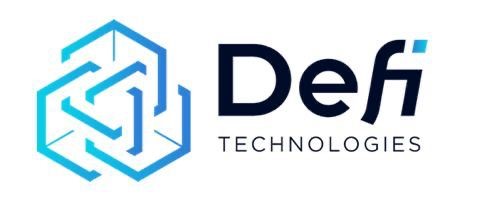DeFi
Valor Inc., filiale de DeFi Technologies, et The Hashgraph

- Cérémonie de clôture : La célébration qui s’est déroulée dans la salle des marchés principale de la Bourse de Francfort, avec la participation de Valor Inc. et de la Hashgraph Association, a attiré l’attention des principaux leaders du secteur et des investisseurs, marquant le lancement du premier ETP (Exchange Traded Product) Valor Hedera (HBAR) au monde, sous ISIN. : CH1213604528.
- Expansion des ETP de certificats et première sonnerie de certificat au monde : La filiale de DeFi Technologies, Valor Inc., a annoncé une nouvelle offre de produits lançant le produit négocié en bourse (ETP) Valor Hedera (HBAR) en collaboration avec The Hashgraph Association (THA) – une organisation basée en Suisse qui se concentre sur la création d’un avenir numérique pour tous. en tirant parti de la technologie de grand livre distribué (DLT) écologique d’Hedera, régie par les plus grandes organisations mondiales.
- Importance d’Hedera : Hedera est un réseau public décentralisé et open source de premier plan, remarquable pour son mécanisme de consensus Proof-of-Stake (PoS) économe en énergie. Il est régi par un conseil d’organisations mondiales indépendantes composé d’entreprises Fortune 500 et d’universités prestigieuses, dont de grandes sociétés telles que Google, IBM, Boeing, Dell, Deutsche Telekom, Standard Bank et LG Electronics. HBAR, la monnaie native de l’Hedera, est utilisée pour les frais d’utilisation du réseau et la sécurité du réseau et se classe parmi les trente premières crypto-monnaies au monde avec une capitalisation boursière de 3,1 milliards de dollars1.
TORONTO, 19 juin 2024 (GLOBE NEWSWIRE) — DeFi Technologies Inc. (le «Entreprise” ou “Technologies DeFi“) (CBOE CA : DEFI) (GR : MB9) (OTC : DEFTF), une société de technologie crypto native qui est pionnière dans la convergence des marchés de capitaux traditionnels avec le monde de la finance décentralisée («DéFi“), annonce fièrement que sa filiale Valor Inc. (“Valeur“), un émetteur majeur de produits négociés en bourse (“ETP“) qui offrent un accès simplifié aux actifs numériques, a lancé l’ETP Valor Hedera (HBAR). En collaboration avec L’Association Hashgraph (THA)une organisation basée en Suisse à la pointe du numérique et de l’autonomisation des solutions d’entreprise et des applications décentralisées sur le réseau Hedera, cet événement historique a été célébré par une cérémonie de clôture à la salle des marchés principale de la Bourse de Francfort, le 18 juin. Cet événement qui a sonné la cloche a commémoré le tout premier produit échangé par la Börse Frankfurt contre une crypto-monnaie.
La cérémonie de clôture à la Bourse de Francfort a marqué le lancement de l’ETP Valor Hedera (HBAR), attirant l’attention des principaux leaders du secteur et des investisseurs. Ce nouveau produit souligne l’engagement de Valour à élargir son portefeuille d’ETP et à améliorer l’accessibilité du marché pour les actifs numériques sur les bourses traditionnelles.
« Alors que nous lançons le premier ETP Hedera (HBAR) au monde, nous n’offrons pas seulement un produit d’investissement ; nous fournissons aux investisseurs une passerelle leur permettant d’accéder facilement aux solides capacités du réseau Hedera et d’en tirer parti », a déclaré Elaine Buehler, responsable produit chez Valor Europe AG. “Ce produit simplifie le processus, permettant aux investisseurs de participer à l’avenir de la technologie blockchain d’entreprise avec une facilité et une sécurité sans précédent.”
L’ETP Valor Hedera (HBAR) est un ajout important à la gamme d’offres de Valour, conçu pour fournir aux investisseurs institutionnels un accès sécurisé et simple à la crypto-monnaie native de Hedera, Hedera HBAR. Ce lancement fait partie de la stratégie plus large de Valour visant à accroître la disponibilité des produits d’actifs numériques sur les bourses traditionnelles.
Hedera HBAR est la crypto-monnaie native et économe en énergie du réseau public Hedera DLT. Les HBAR Hedera sont utilisés pour payer les frais de transaction des applications et protéger le réseau contre les attaques grâce à la preuve de participation et à son algorithme de consensus de hashgraph asynchrone byzantin tolérant aux pannes (aBFT). HBAR a une capitalisation boursière d’environ 3,7 milliards de dollars américains et se classe parmi les Top 30 des crypto-monnaies dans le monde selon CoinMarketcap.
Hedera est un registre public décentralisé, open source et à preuve de participation qui utilise l’algorithme de consensus hashgraph sans leader et asynchrone de tolérance aux pannes byzantine (aBFT). Il est régi par un conseil décentralisé et résistant à la collusion composé d’entreprises, d’universités et de projets Web3 de premier plan du monde entier. Hedera est construit différemment des autres blockchains. Il a un débit élevé avec une finalité rapide ; des frais faibles et prévisibles ; ordonnancement équitable des transactions avec horodatages consensuels ; et une base de code robuste qui garantit l’évolutivité et la fiabilité à chaque couche de son infrastructure réseau. Hedera est gouvernée de manière responsable par les plus grandes organisations mondiales pour garantir que le réseau résiste à la collusion.
« La Hashgraph Association est heureuse de s’engager avec Valor pour lancer ce tout premier ETP Valor Hedera (HBAR) hors d’Europe. Cette réalisation est conforme à notre objectif d’amener les investisseurs institutionnels vers Web3 et de leur permettre d’investir dans des actifs numériques bancables en tant qu’investissement innovant et alternatif pour la diversification de portefeuille. Les investisseurs peuvent entrer dans le domaine des actifs numériques grâce à cet ETP structuré et conforme à la réglementation proposé par Valour. Pour les investisseurs soucieux de l’environnement et des critères ESG, HBAR est également le jeton utilitaire le plus économe en énergie au monde, utilisé pour payer les frais de transaction des applications et protéger la technologie de grand livre distribué Hedera («DLT“) réseau”, déclare Stefan Deiss, co-fondateur et directeur du conseil d’administration de la Hashgraph Association.
« Le lancement de Valor Hedera (HBAR) représente une double première mondiale. Pour la première fois, l’actif cryptographique Hedera peut être intégré à n’importe quel portefeuille ou compte bancaire traditionnel aussi facilement et de manière transparente que n’importe quelle autre action ou obligation. De plus, pour la toute première fois, la cloche d’un ETP crypto sera sonnée dans la zone des certificats de la Bourse de Francfort. Nous sommes très reconnaissants à la Hashgraph Association de nous avoir sélectionnés pour une telle première mondiale », a ajouté Marco A. Infuso, directeur des ventes de Valor Europe AG.
À propos de l’association Hashgraph
La Hashgraph Association est à l’avant-garde de l’habilitation numérique et de l’autonomisation des organisations grâce à l’adoption généralisée de solutions d’entreprise et d’applications décentralisées basées sur Hedera, ce qui comprend le soutien et le financement de programmes de formation, d’innovation et de création d’entreprises à l’échelle mondiale. En tant qu’organisation à but non lucratif dont le siège est en Suisse, la Hashgraph Association finance l’innovation, la recherche et le développement qui permettent l’inclusion économique et un avenir numérique pour tous, avec un impact environnemental, social et de gouvernance (ESG) positif. Pour plus d’informations sur la Hashgraph Association, visitez www.hashgraph-association.com.
À propos des technologies DeFi
DeFi Technologies Inc. (CBOE CA : DEFI) (GR: R9B) (OTC : DEFTF) est une société de technologie financière pionnière dans la convergence des marchés de capitaux traditionnels avec le monde de la finance décentralisée (DeFi). En se concentrant spécifiquement sur les technologies Web3 de pointe du secteur, DeFi Technologies vise à fournir un accès généralisé aux investisseurs à l’avenir de la finance. Soutenus par une équipe estimée d’experts possédant une vaste expérience des marchés financiers et des actifs numériques, nous nous engageons à révolutionner la façon dont les individus et les institutions interagissent avec l’écosystème financier en évolution. Rejoignez la communauté numérique de DeFi Technologies sur Linkedin et Twitteret pour plus de détails, visitez https://defi.tech/
À propos de Valor
Valor Inc. et Valor Digital Securities Limited (ensemble, «Valeur») émet des produits négociés en bourse («ETP ») qui permettent aux investisseurs particuliers et institutionnels d’accéder à des actifs numériques comme Bitcoin de manière simple et sécurisée via leur compte bancaire traditionnel. Valor fait partie du secteur d’activité de gestion d’actifs de DeFi Technologies Inc. (CBOE CA : DEFI) (GR: R9B) (OTC : DEFTF).
En plus de leur nouvelle plateforme d’actifs numériques adossés à des supports physiques, qui comprend 1Valour Bitcoin Physique Carbone Neutre ETP, 1Jalonnement physique Valour Ethereumet Jalonnement physique des ordinateurs Internet 1Valour, Valor propose des ETP d’actifs numériques entièrement couverts avec des frais de gestion faibles à nuls, avec des référencements de produits sur les bourses, banques et plateformes de courtage européennes. La gamme de produits existante de Valour comprend Valor Uniswap (Uni), Cardano (ADA), Pois (POINT), Solana (SOL), Avalanche (AVAX), Cosmos (ATOME), Binance (BNB), Ondulation (XRP), Toncoin (TONNE), ordinateur Internet (PCI), Maillon de chaîne (LIEN) Enjin (ENJ), Valor Bitcoin Staking (BTC), Bitcoin neutre en carbone (BTCN), Valor Hedera (ETP), Panier d’actifs numériques Valor 10 (VDAB10) et 1Valour STOXX Bitcoin Suisse Actif numérique Blue Chip ETP avec des frais de gestion faibles. Les produits phares de Valour sont Bitcoin Zero et Ethereum Zero, les premiers produits d’investissement passifs entièrement couverts avec Bitcoin (BTC) et Ethereum (ETH) comme sous-jacents totalement gratuits.
Pour plus d’informations sur Valour, pour vous abonner ou pour recevoir des mises à jour et des informations financières, visitez valeur.com.
Mise en garde concernant les informations prospectives :
Ce communiqué de presse contient des « informations prospectives » au sens de la législation canadienne sur les valeurs mobilières applicable. Les informations prospectives comprennent, sans toutefois s’y limiter, l’ETP Valor Hedera (HBAR) ; Hedera HBAR; développement d’ETP ; la demande future d’ETP ; l’environnement réglementaire en ce qui concerne la croissance et l’adoption de la finance décentralisée ; la poursuite par DeFi et ses filiales d’opportunités d’affaires ; et les mérites ou les rendements potentiels de telles opportunités. Les informations prospectives sont soumises à des risques, incertitudes et autres facteurs connus et inconnus qui peuvent faire en sorte que les résultats, le niveau d’activité, la performance ou les réalisations réels de la Société, selon le cas, soient sensiblement différents de ceux exprimés ou sous-entendus par ces informations prospectives. Ces risques, incertitudes et autres facteurs incluent, sans toutefois s’y limiter, l’acceptation des produits négociés en bourse Valor par les bourses ; la croissance et le développement du secteur de la finance décentralisée et des cryptomonnaies ; règles et réglementations concernant la finance décentralisée et la crypto-monnaie ; incertitudes générales liées aux affaires, à l’économie, à la concurrence, à la politique et à la société. Bien que la Société ait tenté d’identifier des facteurs importants qui pourraient faire en sorte que les résultats réels diffèrent sensiblement de ceux contenus dans les informations prospectives, il peut y avoir d’autres facteurs qui font que les résultats ne seront pas ceux anticipés, estimés ou espérés. Rien ne garantit que ces informations s’avéreront exactes, car les résultats réels et les événements futurs pourraient différer sensiblement de ceux anticipés dans ces déclarations. Par conséquent, les lecteurs ne doivent pas se fier indûment aux informations prospectives. La Société ne s’engage pas à mettre à jour les informations prospectives, sauf conformément aux lois sur les valeurs mobilières applicables.
Ce communiqué de presse ne constitue pas une offre de vente ni une sollicitation d’offre d’achat de titres aux États-Unis. Les titres offerts dans le cadre de l’Offre n’ont pas été et ne seront pas enregistrés en vertu du United States Securities Act de 1933, tel que modifié (le « US Securities Act ») ou de toute loi sur les valeurs mobilières d’un État et ne peuvent pas être offerts ou vendus aux États-Unis ou à des personnes des États-Unis, à moins qu’ils ne soient enregistrés en vertu du US Securities Act et des lois sur les valeurs mobilières des États applicables ou qu’une dispense d’un tel enregistrement soit disponible.
LA BOURSE CBOE CANADA DÉCLINE TOUTE RESPONSABILITÉ QUANT À L’ADÉQUATION OU À L’EXACTITUDE DE CE COMMUNIQUÉ
Clause de non-responsabilité: Le logo et la marque Hedera sont utilisés pour désigner le réseau Hedera et sa crypto-monnaie native, HBAR. Hedera est une marque déposée de Hedera Hashgraph, LLC, tous droits réservés. Hedera ni aucun des membres du conseil d’administration d’Hedera n’ont participé à la création de cet ETP réglementé en Europe.
Pour plus d’informations, veuillez contacter :
Olivier Roussy-Newton
Directeur général
ir@defi.tech
(323) 537-7681
________________________
1 https://coinmarketcap.com
DeFi
Haust Network Partners with Gateway to Connect to AggLayer

Dubai, United Arab Emirates, August 1, 2024, Chainwire
Consumer adoption of cryptocurrencies is a snowball that is accelerating by the day. More and more people around the world are clamoring for access to DeFi. However, the user interface and user experience of cryptocurrencies still lag behind their fundamental utility, and users lack the simple and secure access they need to truly on-chain products.
Haust Network is a network and suite of products focused on changing this paradigm and bringing DeFi to the masses. To achieve this goal, Haust Network has announced its far-reaching partnership with bridgeseasoned veterans in rapidly delivering revolutionary blockchain utilities for projects. The Gateway team empowers blockchain developers to build DAOs, NFT platforms, payment services, and more. They drive adoption of crypto primitives for individuals and institutions around the world by helping everyone build their on-chain presence.
Gateway specializes in connecting sovereign blockchains to the Aggregation Layer (AggLayer). The AggLayer is a single unified contract that powers the Ethereum bridge of many disparate blockchains, allowing them all to connect to a single unified liquidity pool. The AggLayer abstracts away the complexities of cross-chain DeFi, making tedious multi-chain transactions as easy for the end user as a single click. It’s all about creating access to DeFi, and with Polygon’s technology and the help of Gateways, Haust is doing just that.
As part of their partnership, Gateway will build an advanced zkEVM blockchain for Haust Network, leveraging its extensive experience to deploy ultra-fast sovereign applications with unmatched security, and enabling Haust Network to deliver its products to its audience.
The recently announced launch of the Haust Wallet is a Telegram mini-app that provides users with access to DeFi directly through the Telegram interface. Users who deposit funds into the wallet will have access to all standard send/receive services and generate an automatic yield on their funds. The yield is generated by Haust Network’s interconnected network of smart contracts, Haustoria, which provides automated and passive DeFi yielding.
As part of this partnership, the Haust Network development team will work closely with Gateway developers to launch Haust Network. Gateway is an implementation provider for Polygon CDK and zkEVM technology, which the Haust wallet will leverage to deliver advanced DeFi tools directly to the wallet users’ fingertips. Haust’s partnership with Gateway comes shortly after the announcement of a high-profile alliance with the Polygon community. Together, the three will work to build Haust Network and connect its products to the AggLayer.
About Haust Network
Haust Network is an application-based absolute liquidity network and will be built to be compatible with the Ethereum Virtual Machine (EVM). Haust aims to provide native yield to all users’ assets. In Telegram’s Haust Wallet, users can spend and collect their cryptocurrencies in one easy place, at the same time. Haust operates its network of self-balancing smart contracts that interact across multiple blockchains and then efficiently funnel what has been generated to Haust users.
About Gateway
bridge is a leading white-label blockchain provider that offers no-code protocol deployment. Users can launch custom blockchains in just ten minutes. They are an implementation provider for Polygon CDK and have already helped projects like Wirex, Gnosis Pay, and PalmNFT bring new utility to the crypto landscape.
About Polygon Labs
Polygon Laboratories Polygon Labs is a software development company building and developing a network of aggregated blockchains via the AggLayer, secured by Ethereum. As a public infrastructure, the AggLayer will aggregate the user bases and liquidity of any connected chain, and leverage Ethereum as the settlement layer. Polygon Labs has also contributed to the core development of several widely adopted scaling protocols and tools for launching blockchains, including Polygon PoS, Polygon zkEVM, and Polygon Miden, which is currently under development, as well as the Polygon CDK.
Contact
Lana Kovalski
haustnetwork@gmail.com
DeFi
Ethena downplays danger of letting traders use USDe to back risky bets – DL News

- Ethena and ByBit will allow derivatives traders to use USDe as collateral.
- There is a risk in letting traders use an asset partially backed by derivatives to place more bets.
Ethena has downplayed the dangers of a new feature, which will allow traders to put up its synthetic dollar USDe as collateral when trading derivatives, which are risky bets on the prices of crypto assets.
While allowing users to underwrite their trades with yield-bearing USDe is an attractive prospect, Ethena said there is potential risk in letting traders use an asset partially backed by derivatives to place even more derivatives bets.
“We have taken this risk into account and that is why Ethena operates across more than five different sites,” said Conor Ryder, head of research at Ethena Labs. DL News.
The move comes as competition in the stablecoin sector intensifies.
In recent weeks, PayPal grown up the amount of its stablecoin PYUSD in circulation 96%, while the MakerDAO cooperative plans a rebrandingaiming to increase the supply of its DAI stablecoin to 100 billion.
US dollar growth stagnates
It comes as Ethena has lost momentum after its blockbuster launch in December.
In early July, USDe reached a record level of 3.6 billion in circulation.
That figure has now fallen by 11% to around 3.2 billion.
Join the community to receive our latest stories and updates
New uses for USDe could boost demand for Ethena’s products.
This is where the new plan, announcement Tuesday with ByBit, one of its partner exchanges, is coming.
Ethena users create USDe by depositing Bitcoin or Ether into the protocol.
Ethena then covers these deposits with short positions – bearish bets – on the corresponding asset.
This creates a stable support for USDe, unaffected by price fluctuations in Bitcoin or Ether.
Mitigate risks
While using USDe as collateral for derivatives trading is proving popular, it is unclear what the effects will be if the cryptocurrency market experiences major fluctuations.
Using derivatives as collateral to place more bets has already had disastrous effects.
In June 2022, Lido’s liquid staking token stETH broke its peg to Ether following the fallout from the Terra collapse.
Many traders who used looping leverage to increase their stETH staking yields were liquidated, creating a cascade that caused the price of Ether to drop by more than 43%.
Ethena Labs founder Guy Young said: DL News His office and his partners have taken many precautions.
Ethena spreads bearish bets supporting the USDe across the five exchanges it partners with.
According to Ethena, 48% of short positions supporting USDe are on Binance, 23% on ByBit, 20% on OKX, 5% on Deribit, and 1% on Bitget. website.
In doing so, Ethena aims to minimize the impact of an unforeseen event on a stock market.
The same theory applies to the distribution of risks across different supporting assets.
Fifty percent of USDe is backed by Bitcoin, 30% by Ether, 11% by Ether liquid staking tokens, and 8% by Tether’s USDT stablecoin.
Previous reviews
Ethena has already been criticised regarding the risks associated with USDe.
Some have compared USDe to TerraUSD, an undercollateralized stablecoin that collapsed in 2022.
“It’s not a good design for long-term stability,” said Austin Campbell, an assistant professor at Columbia Business School. said as the USDe launch approaches.
Young replied to critics, saying the industry needs to be more diligent and careful when “marketing products to users who might not understand them as well as we do.”
Ethena has since added a disclaimer on its website stating that USDe is not the same as a fiat stablecoin like USDC or USDT.
“This means that the risks involved are inherently different,” the project says on its website.
Tim Craig is DL News DeFi correspondent based in Edinburgh. Feel free to share your tips with us at tim@dlnews.com.
DeFi
Cryptocurrency and defi firms lost $266 million to hackers in July

In July 2024, the cryptocurrency industry suffered a series of devastating attacks, resulting in losses amounting to approximately $266 million.
Blockchain Research Firm Peck Shield revealed in an X post On August 1, attacks on decentralized protocols in July reached $266 million, a 51% increase from $176 million reported in June.
The most significant breach last month involved WazirX, one of India’s largest cryptocurrency exchanges, which lost $230 million in what appears to be a highly sophisticated attack by North Korean hackers. The attack was a major blow to the stock market, leading to a break in withdrawals. Subsequently, WazirX launched a program in order to recover the funds.
Another notable incident involved Compound Finance, a decentralized lending protocol, which suffered a governance attack by a group known as the “Golden Boys,” who passed a proposal who allocated 499,000 COMP tokens – valued at $24 million – to a vault under their control.
The cross-chain liquidity aggregation protocol LI.FI also fell victim On July 16, a hack resulted in losses of $9.73 million. Additionally, Bittensor, a decentralized machine learning network, was one of the first protocols to suffer an exploit last month, loming $8 million on July 3 due to an attack targeting its staking mechanism.
Meanwhile, Rho Markets, a lending protocol, suffered a $7.6 million breach. However, in an interesting twist, the exploiters research to return the stolen funds, claiming the incident was not a hack.
July 31, reports The Terra blockchain protocol was also hacked, resulting in a loss of $6.8 million across multiple cryptocurrencies. As crypto.news reported, the attack exploited a reentrancy vulnerability that had been identified a few months ago.
Dough Finance, a liquidity protocol, lost $1.8 million in Ethereum (ETH) and USD Coin (USDC) to a flash loan attack on July 12. Similarly, Minterest, a lending and borrowing protocol, saw a loss of $1.4 million due to exchange rate manipulation in one of its markets.
Decentralized staking platform MonoSwap also reported a loss of $1.3 million following an attack that allowed the perpetrators to withdraw the liquidity staked on the protocol. Finally, Delta Prime, another decentralized finance platform, suffered a $1 million breach, although $900,000 of the stolen funds was later recovered.
DeFi
The Rise of Bitcoin DeFi: Then and Now

The convergence of Bitcoin’s robust security and Layer 2 scaling solutions has catalyzed the emergence of a vibrant DeFi ecosystem.
By expanding Bitcoin’s utility beyond simple peer-to-peer payments, these advancements have opened up a new frontier of financial possibilities, allowing users to participate in decentralized lending, trading, and other complex smart contract operations on Bitcoin.
Read on to learn about the rise of Bitcoin-based decentralized finance and how the space has expanded to accommodate a new generation of native assets and features.
Note: If you want to learn candlesticks and chart trading from scratch, this is the best book available on Amazon! Get the book now!
What is DeFi?
Decentralized finance (DeFi) represents a paradigm shift in financial services, offering internet-based financial products such as trading, lending, and borrowing through the use of decentralized public blockchains.
By implementing blockchains, smart contracts, and digital assets, DeFi protocols provide financial services through a decentralized ecosystem, where participants do not have to deal with intermediaries when transacting.
What is Bitcoin DeFi?
The inherent limitations of the Bitcoin mainchain in supporting the intricacies of decentralized finance have created the need to develop smart contract-based Layer 2 solutions.
Additionally, the advent of the Ordinals protocol in 2023, which facilitated the emergence of fungible token standards such as BRC-20 and Runes, catalyzed the growth of DeFi on the Bitcoin blockchain.
This expansion in protocol diversity has broadened the applications of the world’s leading cryptocurrency network beyond the core base-layer use cases around value preservation and transactional capabilities.
Therefore, Bitcoin DeFi has become a nascent sector within the digital asset market, after previously being a missing essential part of the Bitcoin ecosystem.
Bitcoin DeFi in its early days
Integrating decentralized finance (DeFi) concepts into the Bitcoin ecosystem has been a journey of innovation and perseverance. Early attempts to bridge the gap between Bitcoin’s fundamental simplicity and DeFi’s complexities have spawned pioneering projects that, while laying essential foundations, have also encountered significant obstacles.
Colored coins
Colored coins represented an early foray into tokenizing real-world assets on the Bitcoin blockchain. By leveraging the existing network to track ownership of assets ranging from stocks to real estate, this approach highlighted Bitcoin’s potential as a platform beyond digital currency. However, scalability and practical implementation challenges have limited its widespread adoption.
Counterpart
Building on the colored coins, Counterparty has become a platform for creating and trading digital assets, including non-fungible tokens (NFTs), on Bitcoin.
The introduction of popular projects like Rare Pepe NFTs has demonstrated the growing appeal of digital collectibles. However, constraints around user experience and network efficiency have hampered its full potential.
These early experiments, while not fully realizing their ambitions, served as valuable stepping stones, informing Bitcoin DeFi’s subsequent developments. Their challenges highlighted the need for more sophisticated infrastructure and protocols to harness the full potential of decentralized finance on the Bitcoin network.
Bitcoin DeFi Today
Today, building DeFi applications on Bitcoin is primarily done in the realm of Layer 2 (L2) networks. This architectural choice is motivated by the limitations of Bitcoin’s base layer in supporting complex programmable smart contracts.
Bitcoin’s original design prioritized security and decentralization over programmability, making it difficult to develop sophisticated DeFi protocols directly on its blockchain. However, the recent emergence of protocols like Ordinals, BRC-20, and Runes, while not DeFi in their own right, has sparked possibilities for future DeFi-like applications on the main chain.
In contrast, L2 solutions offer a scalable and programmable environment built on Bitcoin, enabling the creation of various DeFi products.
By expanding Bitcoin’s capabilities without compromising its core principles, L2s have become the preferred platform for developers looking to build DeFi applications that encompass trading, lending, staking, and more.
Leading L2 networks such as Lightning Network, Rootstock, Stacks, and Build on Bitcoin provide the infrastructure for these efforts. Some of these L2s have even introduced their own native tokens to the network, further expanding Bitcoin’s DeFi ecosystem.
Essentially, while Bitcoin’s core layer presents challenges for DeFi development, its security and decentralization have provided a foundational layer for the innovative L2 landscape to thrive.
Bitcoin Layer 2 offers a promising path to building a robust and thriving Bitcoin-based DeFi ecosystem that offers trading, staking, lending, and borrowing. All you need is a DeFi Wallet like Xverse to access the new world of decentralized financial services secured by Bitcoin.
Conclusion
The integration of DeFi principles into the Bitcoin ecosystem, primarily facilitated by Layer 2 solutions, marks a significant evolution in the digital asset landscape.
Building on the foundational work of pioneers like Colored Coins and Counterparty, the industry has evolved into more sophisticated platforms like Rootstock, Stacks, and Build on Bitcoin to create a thriving Bitcoin-powered DeFi ecosystem.
Advertisement
-

 News11 months ago
News11 months agoBitcoin soars above $63,000 as money flows into new US investment products
-

 DeFi11 months ago
DeFi11 months agoEthena downplays danger of letting traders use USDe to back risky bets – DL News
-

 News11 months ago
News11 months agoFRA Strengthens Cryptocurrency Practice with New Director Thomas Hyun
-

 DeFi11 months ago
DeFi11 months agoZodialtd.com to revolutionize derivatives trading with WEB3 technology
-

 Markets11 months ago
Markets11 months agoBitcoin Fails to Recover from Dovish FOMC Meeting: Why?
-

 DeFi1 year ago
DeFi1 year ago👀 Lido prepares its response to the recovery boom
-

 Markets1 year ago
Markets1 year agoWhy Bitcoin’s price of $100,000 could be closer than ever ⋆ ZyCrypto
-

 Markets1 year ago
Markets1 year agoWhale Investments in Bitcoin Reached $100 Billion in 2024, Fueling Crazy Investor Optimism ⋆ ZyCrypto
-

 DeFi1 year ago
DeFi1 year agoPancakeSwap integrates Zyfi for transparent, gas-free DeFi
-

 DeFi1 year ago
DeFi1 year ago🏴☠️ Pump.Fun operated by Insider Exploit
-

 Markets1 year ago
Markets1 year agoa resilient industry that defies market turbulence
-

 DeFi1 year ago
DeFi1 year ago👀SEC Receives Updated Spot Ether ETF Filings














